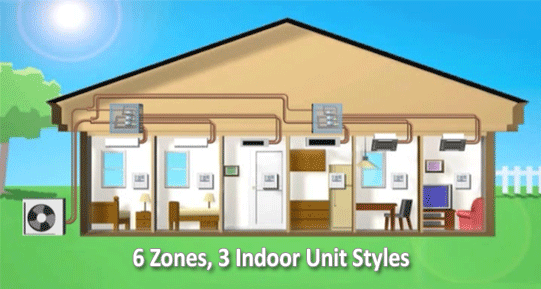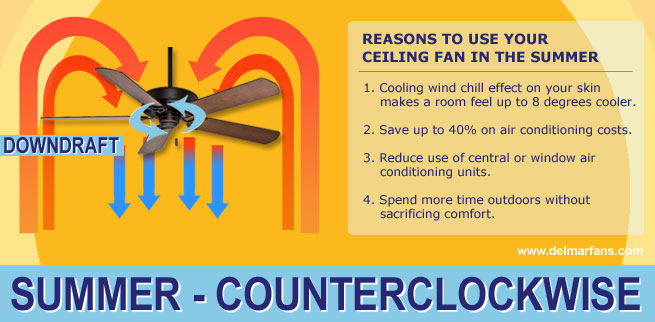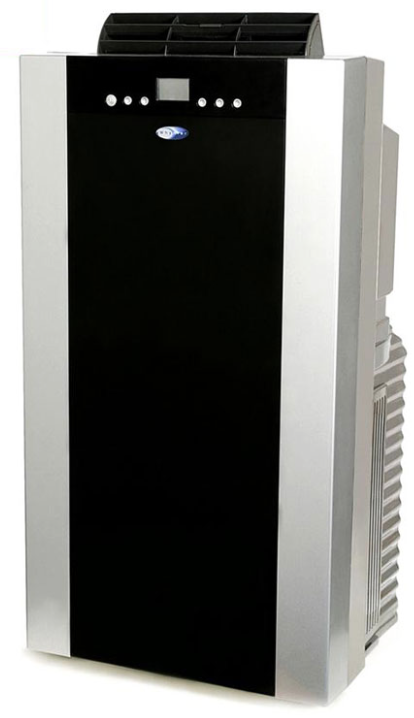As an Amazon Associate, we earn from qualifying purchases. This is without any additional costs for the buyer but does support us in maintaining our website.
If you are planning to purchase an air conditioner, you should understand its technical details and the important factors you need to consider. Getting one for your place becomes an easy task once you do a comparison of the variations according to these aspects.
Types of Air Conditioners
The classification of air conditioners can be based on various factors. Here, they are classified on the area that they can cover.
-
Portable Air Conditioner
It is a small portable air conditioner that gives cooling to a small space. Its exhaust hose is vented out of the area via a window. As the name suggests, this unit can be transported throughout the house depending on the specific need. It is also the most affordable one.
-
Room Air Conditioner
It is designed to cool a single room. It is less costly when compared to a central air conditioning system. It gives cooling only where needed. Depending on its size, it can be plugged to a 115 volt or 230 volt circuit. There are two types of room air conditioners – the window air conditioner and a wall-mounted air conditioner.
-
Mini-Split Air Conditioner
This is considerably quieter as compared to a room air conditioner. The mini-split air conditioner can be used to cool bigger rooms, but it does not need a ducting system unlike a central air conditioner. It has a big condenser unit that is placed outdoor, and a small wall-mounted blower unit that is installed inside the house.
-
Central Air Conditioner
It is considered the most efficient of all kinds of air conditioning systems. It can maintain a steady humidity and temperature within the area. The split system and the packaged unit are the two types of central air conditioning system.
Before You Buy an Air Conditioner
Determine your home appliance budget, and consider a few things to help you obtain the most from your chosen item.
-
Room Dimensions
 The location of the air conditioner is an obvious factor that you must think of. Basically, it could be in the drawing room, the study room, your home office or in the bedroom.
The location of the air conditioner is an obvious factor that you must think of. Basically, it could be in the drawing room, the study room, your home office or in the bedroom.
Regardless of where you prefer to install it, carefully check the dimensions of the area. Choose the type you want to buy according to the area. For a room with a small space, a compact or midsize air conditioner would do.
If the room is a bit bigger, then a smaller sized one cannot provide the necessary cooling, or it might take longer than the usual to cool the place. Remember, an air conditioner of higher energy specifications will use up more electrical power and the parts could wear off faster.
The rule of the thumb is to match the air conditioner with the measurements of the room. In addition, take into consideration the height of the ceiling, the number of windows and the number of people staying in the room.
-
The Exact Spot for the Unit Installation
Have a rough idea of the place along with its capacity. Begin to zero in on the specific area, where you want to install the unit. Typically, they are placed on the windows.
In such cases, measure the accurate size of your window. Pick a window that is close to the bed, or will help the air conditioning unit face the side of the bed. Try to change the pieces of furniture in the room and make adjustments, in case it is not possible to choose the right position of the AC.
-
Power Supply Socket
You should know that an air conditioning system requires an electrical system to support its performance and can withstand the electrical load of the large alternating current that the unit draws. It is important that the plug unit in the wall is able to do handle all the operations. If it is not, you can ask an electrician to put a plug and socket unit that works well with a higher voltage rating.
-
Technical Specifications
Of course, it is not necessary to understand the engineering aspects of the air conditioner, but it is not a bad idea to know some terminologies that may come in handy, if you are shopping for one.
For example, the BTU (British Thermal Unit) is the rating of the cooling capacity energy of the AC system. It is an internationally recognized unit of energy. In other words, the BTU measures the amount of heat that it can take out from the area. Make sure to check the compatibility of the BTU rating to the measurements of the room, so you can get maximized functionality out of the air conditioner.
Another useful terminology is the EER (Energy Efficiency Ratio) rating that is measured by dividing the value of BTU to the number of watts. The higher the EER rating, the better the air conditioner will cool the room efficiently. But the higher the EER, the more costly it is. Apart from these, look into the chassis, filters, thermostat and fan, to ensure that the air conditioning unit will function properly and offer you excellent service.
-
The Accuracy
The majority of air conditioners today have thermostats and timers, which can be customized according to your preference. It is possible to program the unit to a specific temperature for a certain time during the day. Before buying one, check if it has these features. Check its accuracy to the specific setting, if it really does have such features.
-
Its Usability
 Actually, it is different from one person to another, although it plays a vital part in handling the unit. Imagine getting an extravagant air conditioner that provides all the cutting-edge features imaginable, yet is extremely complicated to use.
Actually, it is different from one person to another, although it plays a vital part in handling the unit. Imagine getting an extravagant air conditioner that provides all the cutting-edge features imaginable, yet is extremely complicated to use.
Not all people are knowledgeable about air conditioners. And so, opt for a unit that is simple to operate that everybody can enjoy its functions and never have to worry about pressing a wrong button and destroying it accidentally.
Those are helpful factors to consider before you buy your own air conditioner. Weight is another important factor. For correct installation, there are experts in this field to help you install the appliance.
Another great tip is to combine the use of your ceiling fan with the air conditioning. In this way you can use the more energy efficient ceiling fan all day around and only use the air conditioning unit when really needed.


